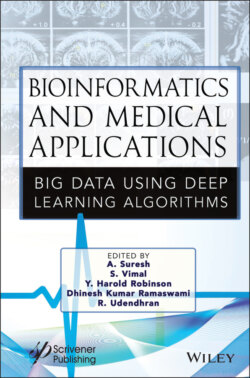Читать книгу Bioinformatics and Medical Applications - Группа авторов - Страница 15
1.2 Literature Review
ОглавлениеOver the years, many strategies have been used regarding data processing and model variability in the field of cardiovascular diagnostics. Authors in [4] show that splitting the data into 70:30 ratio using for tutoring and examination purpose and 10-fold cross proofing putting logistic regression into operation improved the accuracy of the UCI dataset to 87%.
Authors in [5] have used ensemble classification techniques using multiple classifiers followed by score level ensemble for improving the prediction accuracy. They pointed out that maximum voting produces the highest level of development. This functionality is enhanced by using feature selection.
Hybrid approach has been proposed in [6] by consolidating Random Forest along with Linear method leading to a precision of around 90%. In [7], Vertical Hoeffding Decision Tree (VHDT) was used accuracy of 85.43% using 10-fold cross-validation.
Authors in [8] outline a multi-faceted voting system that can anticipate the conceivable presence of coronary illness in humans. It employs four classifiers which are SGD, KNN, Random Forest, and Logistic Regression and joins them in a consolidated way where group formation is performed by a large vote of the species making 90% accuracy.
The strategy utilized in [9] finds these features by way of correlation which can help enhanced prediction results. UCI coronary illness dataset is used to evaluate the result with [6]. Their proposed model accomplished precision of 86.94% which outflanks Hoeffding tree technique which reported accuracy of 85.43%.
Different classifiers, mainly, Decision Tree, NB, MLP, KNN, SCRL, RBF, and SVM have been utilized in [10]. Moreover, integrated methods of bagging, boosting, and stacking have been applied to the database. The results of the examination demonstrate that the SVM strategy utilizing the boosting procedure outflanks the other previously mentioned techniques.
It was exhibited in [11] after various analyses that, if we increase the feature space of RF algorithm while using forecasts and probability of a tuple to belong to a particular class from Naive Bayes model, then we could increase the precision achieved in identifying the categories, by and large.
Studies in [12] suggested that Naive Bayes gives best result when combined with Random Forest. Also, when KNN is combined with RF or RF+NB, the errors remain same suggesting that it is the dominating method.
Authors in [13] compared the precision of various models in classification of coronary disease taking Kaggle dataset of 70,000 records as input. The algorithms used were Random Forest, Naive Bayes, Logistic Regression, and KNN among whom Random Forest was the winner with an accuracy of 73%.
Creators in [14] have fused the results of the AI examination applied on different informational collections focusing on the CAD illness. Common features are compared and extracted from different datasets, and advanced concepts such as fast decision trees and pruned C4.5 tree are administered on it resulting in higher classification accuracy.
Ensemble Optimization is applied in [15] wherein fuzzy logic is used for extraction of features, Genetic Algorithm for reducing them and Neural Network for classifying them. The results have been tested on a sample of size 30 and accuracy achieved is 99.97%
Based on the detailed research discussed above, we analyze by comparing different strategies suggested by different authors in their respective papers. This helps us to quickly understand where we stand presently with respect to these techniques and how they need to mature further.
